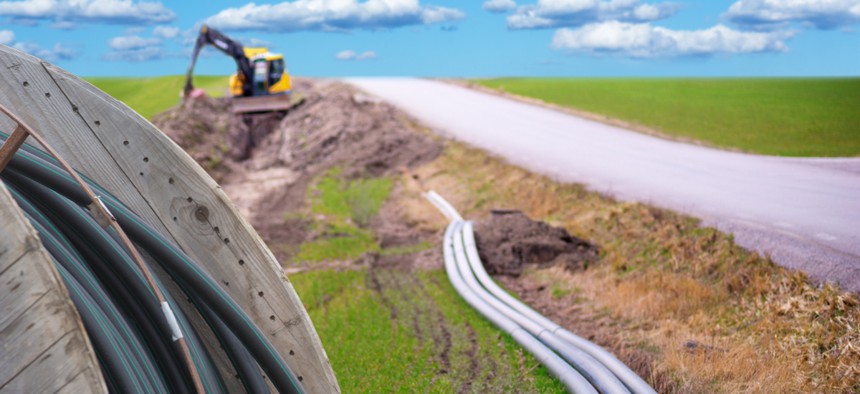Broadband Is Largely Inaccessible to Those Who Need it Most

Amy Johansson/Shutterstock.com
Because of high prices and low accessibility, poor and rural communities are the least likely to subscribe to high-speed internet.
The internet is a way for people in poorer or far-flung communities to connect with social programs and educational opportunities, such as employment and health services, to which they might not otherwise have access. But according to a new report from the Brookings Institution, residents in low-income or rural neighborhoods are the least likely to have broadband subscriptions.
The current standard for broadband in the U.S. is internet with a 25 Mbps (Megabits per second) download speed. Though Netflix says it needs only 5 Mbps to stream video, the 25 Mbps threshold is intended to satisfy the different needs—high-quality downloads, video communication—and multiple demands of a single household’s network. The richer and more educated a neighborhood is, the Brookings report says, the more likely its residents are to have internet that reaches that threshold. While 73 percent of Americans have broadband service in their homes, college graduates are three times more likely to have the subscription than high-school graduates.
In 2015, nearly a quarter of Americans lived in low-subscription neighborhoods, meaning that fewer than 40 percent of households in the area had a broadband connection. The 17.7 million children wholive in low-subscription neighborhoods are particularly impacted by this dearth. As schoolwork becomes increasingly digital, a lack of broadband access makes it difficult for kids to complete homework assignments and research projects.
“You can see a cycle of economic hurdles that certain folks need to overcome that others don’t,” says Adie Tomer, a fellow at the Brookings Institution and co-author of the report. “There are kids in neighborhoods [that were] struggling by other definitions that now are also struggling to have digital connectivity. And what does that mean for their economic future? How do you build the digital skills necessary to access jobs and careers that are coming?”
Rural and low-density areas, especially those in agriculturally focused regions in the South and West, are often underserved. In 2015, one in four residents in rural areas did not have broadband service. But even in metropolitan areas there are still communities that do not have connection subscriptions. “They’re out of this national conversation because people are focused on availability,” says Tomer. He believes that the availability problem will be solved by technological advancements like satellites. Convincing people to subscribe is another issue—and one that Tomer finds more pressing.
Price is undoubtedly the highest barrier to entry. A report from Information Economics and Policy, a research journal, found that it would take a price reduction of roughly 15 percent to increase broadband adoption by even 10 percent. It can be difficult for low-income families to sign up for yet another monthly bill. Additionally, Tomer says, subscribing to a broadband connection means purchasing all of the equipment that goes with it: a computer, a smartphone, or a wi-fi router.
Seventy-seven percent of Americans now own smartphones, which do often provide some internet services. But having a smartphone with wireless capabilities is not the same as having a laptop with a broadband connection. “They are not substitute goods,” says Tomer. “They are complimentary goods. The productivity levels of a desktop or laptop are unparalleled. Wireless connections tend to have data caps, [and] you’re constantly looking for a wi-fi connection because it’s going to be faster.”
For years, many have advocated for calling high-speed internet a basic public right that the government should provide, regulated in the same vein as electricity or water. Finland went this route in 2009: Telecom operators in the country are now required to provide homes and businesses with access to reasonably priced and high-quality internet. As of April 2017, 50 percent of Finnish households had access to broadband connections.
In America, however, the conversation about how to provide people with affordable internet is still in its nascent stage. “Effectively, we do not have any kind of federal mandate on what level of broadband service to provide to people,” Tomer says. Additionally, unlike more mainstream utilities, broadband has little to no regulation. “Until we design what that mandate looks like, we can probably expect to see gaps under availability and adoption,” Tomer adds.
But regulation is unlikely to come about any time soon. Ajit Pai, the new chairman of the Federal Communication Commission (FCC), has been vocal in his support of what he calls “light-touch regulation.” He has vowed to “take a weed wacker” to net neutrality and has closed investigations into telecom giants like Verizon and AT&T that were opened by the previous administration. Tomer compared Pai’s heading the FCC to Scott Pruitt, an opponent of climate change, heading the Environmental Protection Agency. Back in 2015, it appeared that the government was going to include broadband access in Lifeline, a federal program that subsidizes phone service for low-income people. But Pai halted the expansion in February, saying that he was worried about people abusing the program. Some low-income residents rely on the largesse of the private sector to access in-home internet through programs like Internet Essentials, a low-cost internet service provided by Comcast for economically disadvantaged families.
Meanwhile, Tomer worries that the underserved will continue to fall behind as the world moves in an increasingly technological direction.“How do you make sure that you succeed in school if you’re competing with folks immersed in a digital culture and you’re stuck in an analog one?”





